Optimizing IP Addressing for Riverina IT Solutions Network Expansion
VerifiedAdded on 2023/06/10
|9
|1253
|177
Report
AI Summary
This report presents a detailed IP addressing solution designed for Riverina IT Solutions, a medium-sized organization expanding its operations across six sites in regional New South Wales. The solution utilizes the 10.0.0.0 private IP address range and incorporates a router at each site to interconnect the entire network. The design employs variable length subnet masking (VLSM) to efficiently allocate IP addresses to each site based on its workstation count, ranging from 120 to 300, while also accommodating future growth. The report includes a network diagram illustrating the IP structure, subnet allocations, and device configurations. It further addresses the scenario where the number of hosts per network increases to over 1024, outlining the necessary adjustments to the IP addressing plan and the impact on network efficiency, advocating for subnetting to mitigate traffic and improve management. The document highlights the importance of proper subnet planning to avoid network congestion and ensure optimal performance.
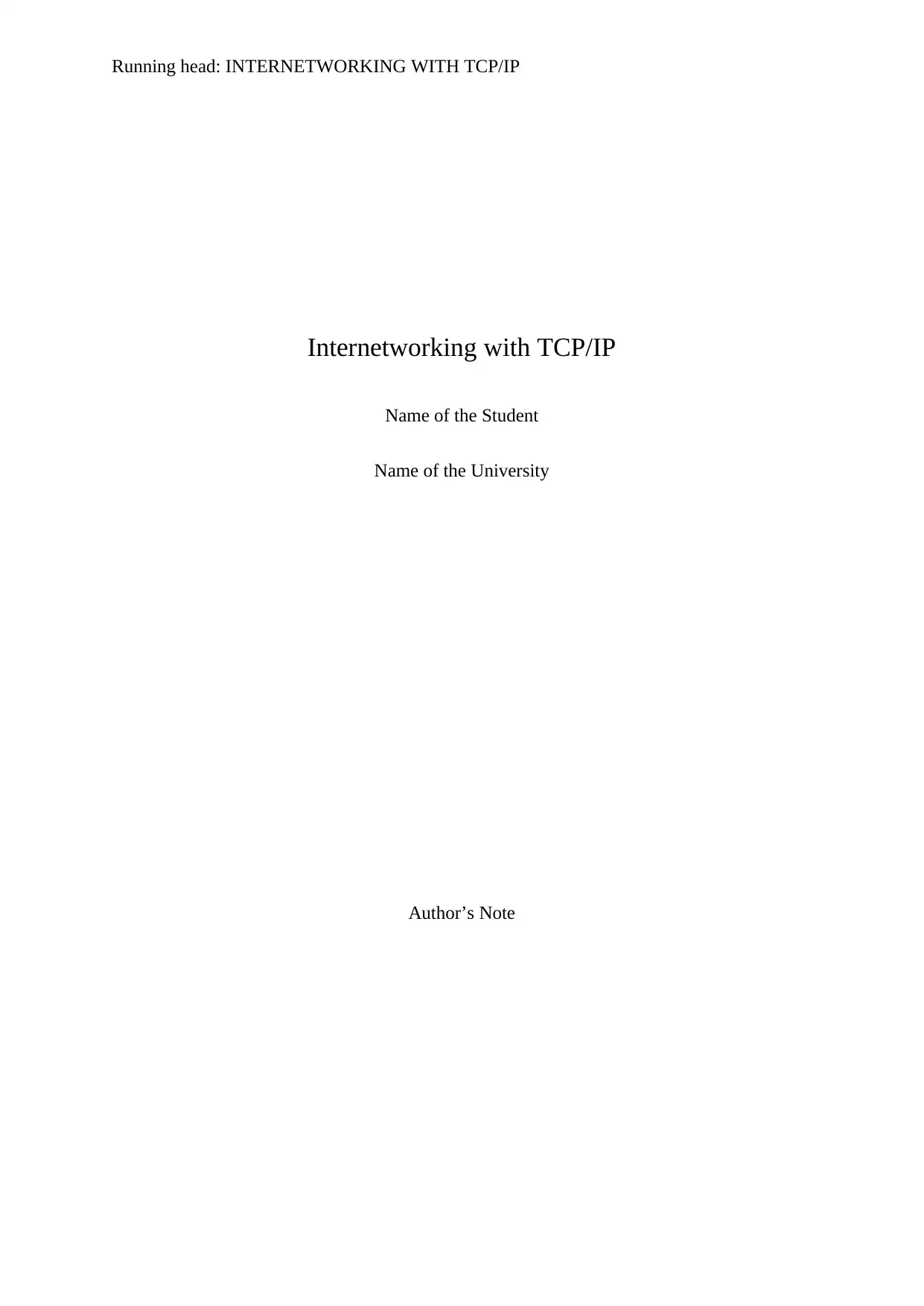
Running head: INTERNETWORKING WITH TCP/IP
Internetworking with TCP/IP
Name of the Student
Name of the University
Author’s Note
Internetworking with TCP/IP
Name of the Student
Name of the University
Author’s Note
Paraphrase This Document
Need a fresh take? Get an instant paraphrase of this document with our AI Paraphraser

1
INTERNETWORKING WITH TCP/IP
Table of Contents
a. Detailed Design of a Simple Addressing Solution.................................................................2
Explanation of the Diagram.......................................................................................................3
b. Explanation if the number of hosts per network jumps to over 1024 per building................4
Bibliography...............................................................................................................................8
INTERNETWORKING WITH TCP/IP
Table of Contents
a. Detailed Design of a Simple Addressing Solution.................................................................2
Explanation of the Diagram.......................................................................................................3
b. Explanation if the number of hosts per network jumps to over 1024 per building................4
Bibliography...............................................................................................................................8
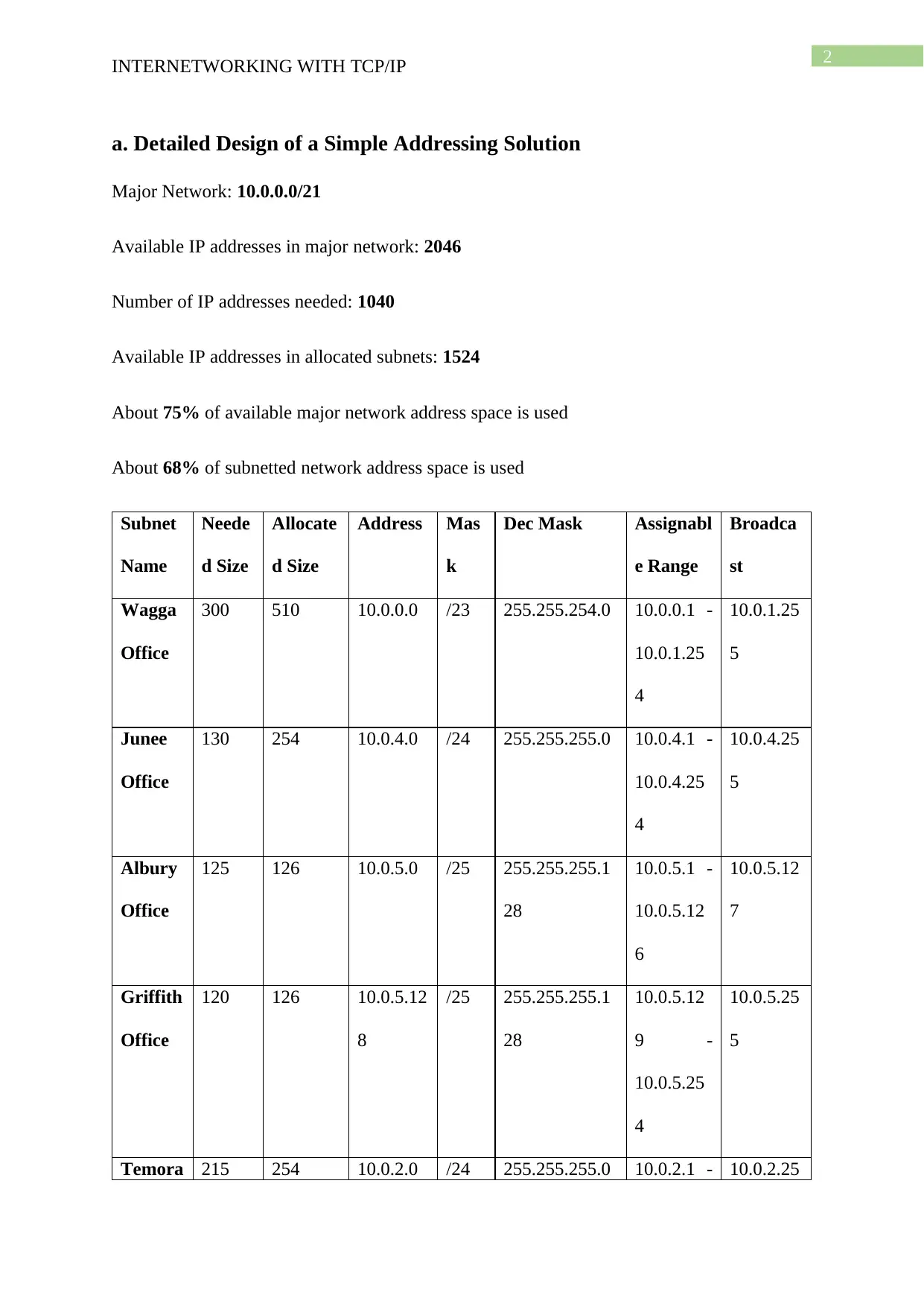
2
INTERNETWORKING WITH TCP/IP
a. Detailed Design of a Simple Addressing Solution
Major Network: 10.0.0.0/21
Available IP addresses in major network: 2046
Number of IP addresses needed: 1040
Available IP addresses in allocated subnets: 1524
About 75% of available major network address space is used
About 68% of subnetted network address space is used
Subnet
Name
Neede
d Size
Allocate
d Size
Address Mas
k
Dec Mask Assignabl
e Range
Broadca
st
Wagga
Office
300 510 10.0.0.0 /23 255.255.254.0 10.0.0.1 -
10.0.1.25
4
10.0.1.25
5
Junee
Office
130 254 10.0.4.0 /24 255.255.255.0 10.0.4.1 -
10.0.4.25
4
10.0.4.25
5
Albury
Office
125 126 10.0.5.0 /25 255.255.255.1
28
10.0.5.1 -
10.0.5.12
6
10.0.5.12
7
Griffith
Office
120 126 10.0.5.12
8
/25 255.255.255.1
28
10.0.5.12
9 -
10.0.5.25
4
10.0.5.25
5
Temora 215 254 10.0.2.0 /24 255.255.255.0 10.0.2.1 - 10.0.2.25
INTERNETWORKING WITH TCP/IP
a. Detailed Design of a Simple Addressing Solution
Major Network: 10.0.0.0/21
Available IP addresses in major network: 2046
Number of IP addresses needed: 1040
Available IP addresses in allocated subnets: 1524
About 75% of available major network address space is used
About 68% of subnetted network address space is used
Subnet
Name
Neede
d Size
Allocate
d Size
Address Mas
k
Dec Mask Assignabl
e Range
Broadca
st
Wagga
Office
300 510 10.0.0.0 /23 255.255.254.0 10.0.0.1 -
10.0.1.25
4
10.0.1.25
5
Junee
Office
130 254 10.0.4.0 /24 255.255.255.0 10.0.4.1 -
10.0.4.25
4
10.0.4.25
5
Albury
Office
125 126 10.0.5.0 /25 255.255.255.1
28
10.0.5.1 -
10.0.5.12
6
10.0.5.12
7
Griffith
Office
120 126 10.0.5.12
8
/25 255.255.255.1
28
10.0.5.12
9 -
10.0.5.25
4
10.0.5.25
5
Temora 215 254 10.0.2.0 /24 255.255.255.0 10.0.2.1 - 10.0.2.25
⊘ This is a preview!⊘
Do you want full access?
Subscribe today to unlock all pages.

Trusted by 1+ million students worldwide
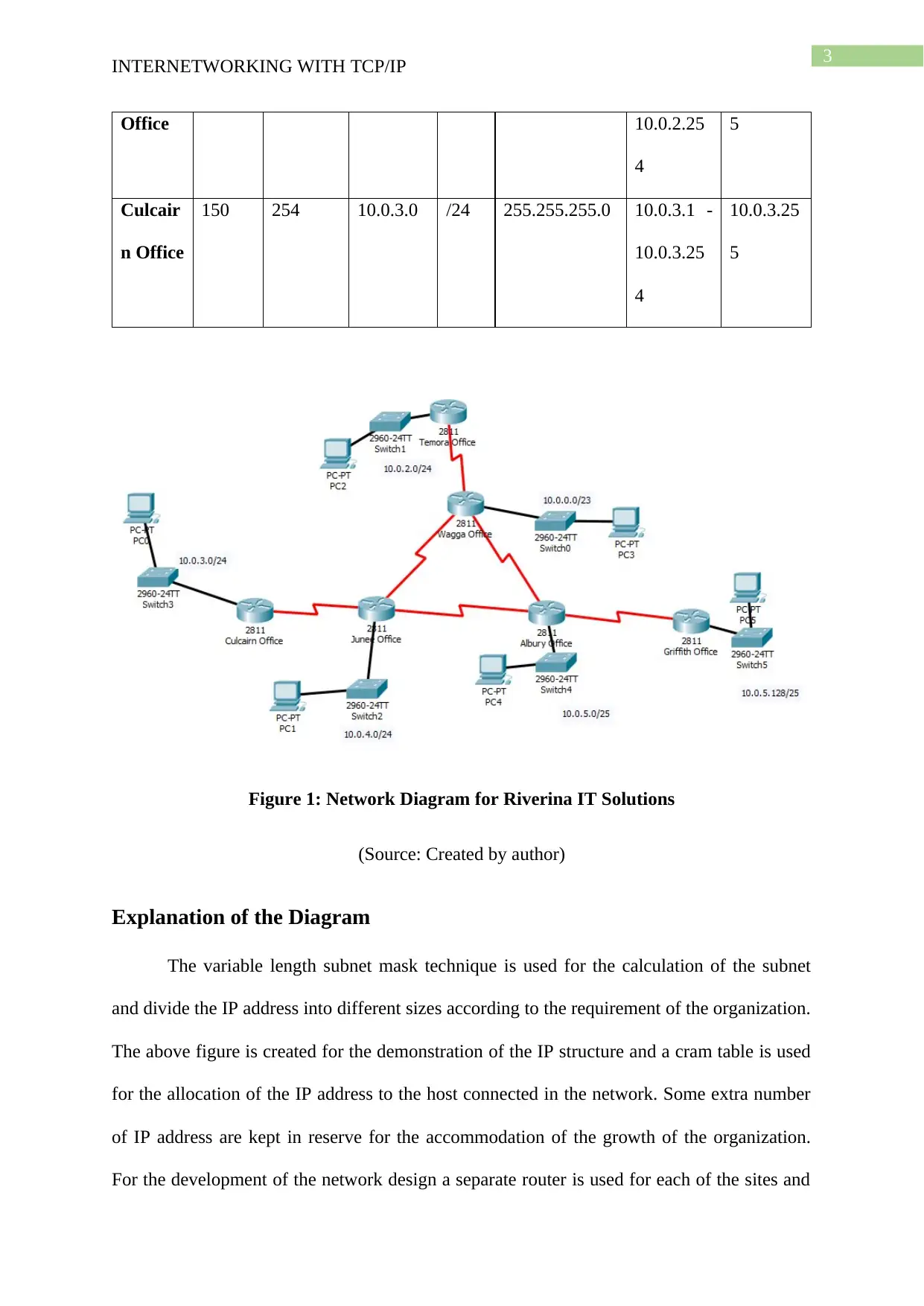
3
INTERNETWORKING WITH TCP/IP
Office 10.0.2.25
4
5
Culcair
n Office
150 254 10.0.3.0 /24 255.255.255.0 10.0.3.1 -
10.0.3.25
4
10.0.3.25
5
Figure 1: Network Diagram for Riverina IT Solutions
(Source: Created by author)
Explanation of the Diagram
The variable length subnet mask technique is used for the calculation of the subnet
and divide the IP address into different sizes according to the requirement of the organization.
The above figure is created for the demonstration of the IP structure and a cram table is used
for the allocation of the IP address to the host connected in the network. Some extra number
of IP address are kept in reserve for the accommodation of the growth of the organization.
For the development of the network design a separate router is used for each of the sites and
INTERNETWORKING WITH TCP/IP
Office 10.0.2.25
4
5
Culcair
n Office
150 254 10.0.3.0 /24 255.255.255.0 10.0.3.1 -
10.0.3.25
4
10.0.3.25
5
Figure 1: Network Diagram for Riverina IT Solutions
(Source: Created by author)
Explanation of the Diagram
The variable length subnet mask technique is used for the calculation of the subnet
and divide the IP address into different sizes according to the requirement of the organization.
The above figure is created for the demonstration of the IP structure and a cram table is used
for the allocation of the IP address to the host connected in the network. Some extra number
of IP address are kept in reserve for the accommodation of the growth of the organization.
For the development of the network design a separate router is used for each of the sites and
Paraphrase This Document
Need a fresh take? Get an instant paraphrase of this document with our AI Paraphraser
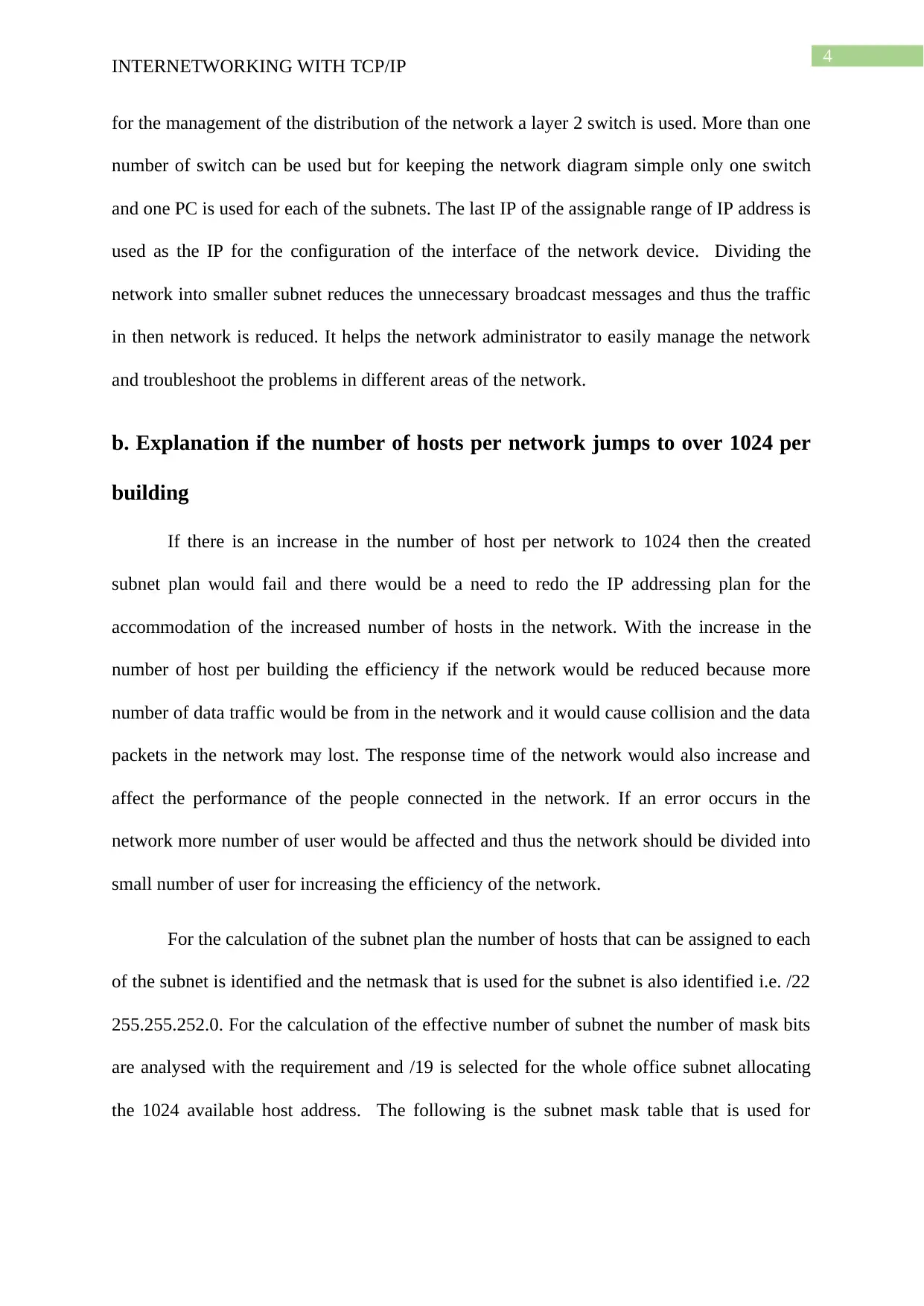
4
INTERNETWORKING WITH TCP/IP
for the management of the distribution of the network a layer 2 switch is used. More than one
number of switch can be used but for keeping the network diagram simple only one switch
and one PC is used for each of the subnets. The last IP of the assignable range of IP address is
used as the IP for the configuration of the interface of the network device. Dividing the
network into smaller subnet reduces the unnecessary broadcast messages and thus the traffic
in then network is reduced. It helps the network administrator to easily manage the network
and troubleshoot the problems in different areas of the network.
b. Explanation if the number of hosts per network jumps to over 1024 per
building
If there is an increase in the number of host per network to 1024 then the created
subnet plan would fail and there would be a need to redo the IP addressing plan for the
accommodation of the increased number of hosts in the network. With the increase in the
number of host per building the efficiency if the network would be reduced because more
number of data traffic would be from in the network and it would cause collision and the data
packets in the network may lost. The response time of the network would also increase and
affect the performance of the people connected in the network. If an error occurs in the
network more number of user would be affected and thus the network should be divided into
small number of user for increasing the efficiency of the network.
For the calculation of the subnet plan the number of hosts that can be assigned to each
of the subnet is identified and the netmask that is used for the subnet is also identified i.e. /22
255.255.252.0. For the calculation of the effective number of subnet the number of mask bits
are analysed with the requirement and /19 is selected for the whole office subnet allocating
the 1024 available host address. The following is the subnet mask table that is used for
INTERNETWORKING WITH TCP/IP
for the management of the distribution of the network a layer 2 switch is used. More than one
number of switch can be used but for keeping the network diagram simple only one switch
and one PC is used for each of the subnets. The last IP of the assignable range of IP address is
used as the IP for the configuration of the interface of the network device. Dividing the
network into smaller subnet reduces the unnecessary broadcast messages and thus the traffic
in then network is reduced. It helps the network administrator to easily manage the network
and troubleshoot the problems in different areas of the network.
b. Explanation if the number of hosts per network jumps to over 1024 per
building
If there is an increase in the number of host per network to 1024 then the created
subnet plan would fail and there would be a need to redo the IP addressing plan for the
accommodation of the increased number of hosts in the network. With the increase in the
number of host per building the efficiency if the network would be reduced because more
number of data traffic would be from in the network and it would cause collision and the data
packets in the network may lost. The response time of the network would also increase and
affect the performance of the people connected in the network. If an error occurs in the
network more number of user would be affected and thus the network should be divided into
small number of user for increasing the efficiency of the network.
For the calculation of the subnet plan the number of hosts that can be assigned to each
of the subnet is identified and the netmask that is used for the subnet is also identified i.e. /22
255.255.252.0. For the calculation of the effective number of subnet the number of mask bits
are analysed with the requirement and /19 is selected for the whole office subnet allocating
the 1024 available host address. The following is the subnet mask table that is used for
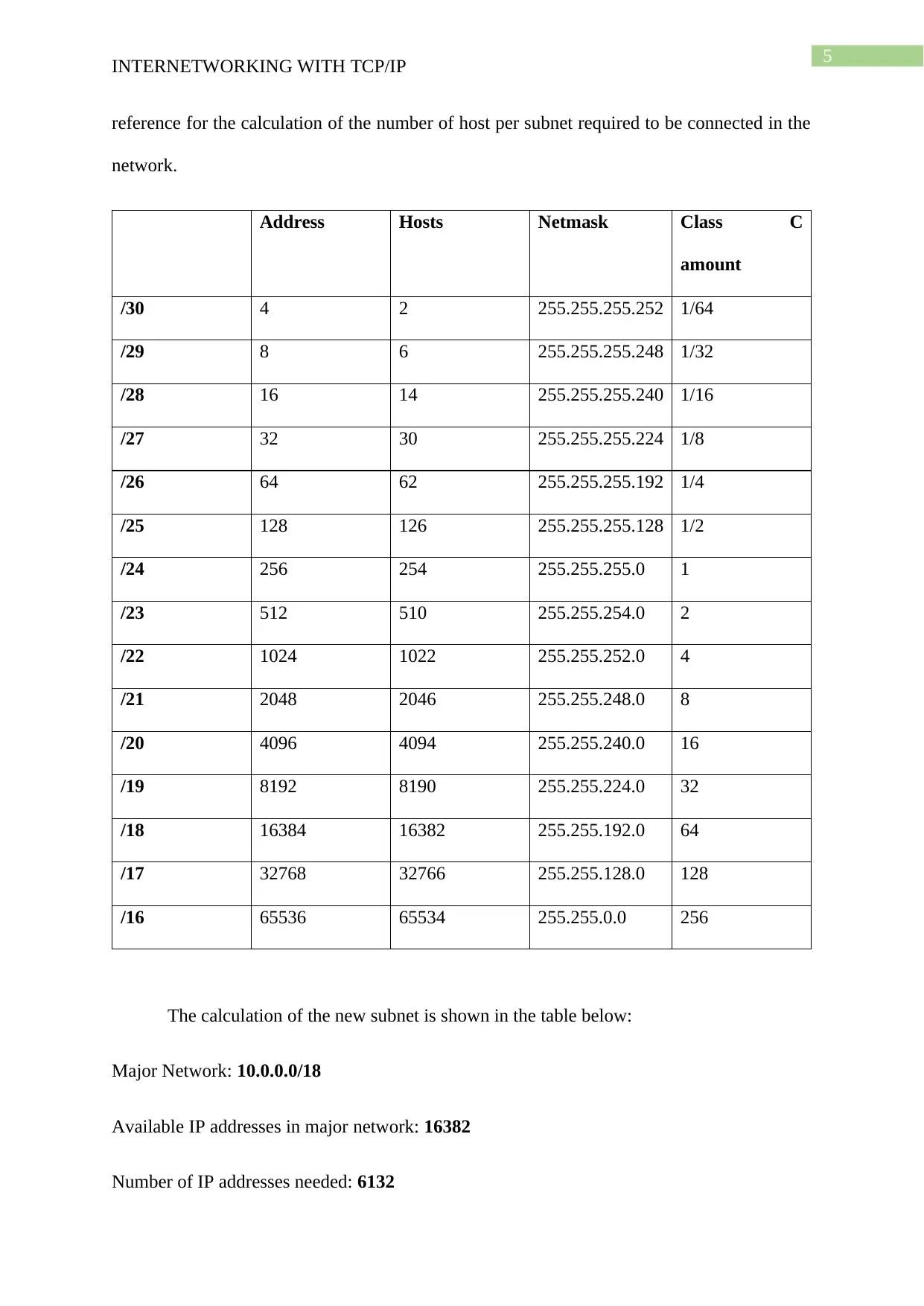
5
INTERNETWORKING WITH TCP/IP
reference for the calculation of the number of host per subnet required to be connected in the
network.
Address Hosts Netmask Class C
amount
/30 4 2 255.255.255.252 1/64
/29 8 6 255.255.255.248 1/32
/28 16 14 255.255.255.240 1/16
/27 32 30 255.255.255.224 1/8
/26 64 62 255.255.255.192 1/4
/25 128 126 255.255.255.128 1/2
/24 256 254 255.255.255.0 1
/23 512 510 255.255.254.0 2
/22 1024 1022 255.255.252.0 4
/21 2048 2046 255.255.248.0 8
/20 4096 4094 255.255.240.0 16
/19 8192 8190 255.255.224.0 32
/18 16384 16382 255.255.192.0 64
/17 32768 32766 255.255.128.0 128
/16 65536 65534 255.255.0.0 256
The calculation of the new subnet is shown in the table below:
Major Network: 10.0.0.0/18
Available IP addresses in major network: 16382
Number of IP addresses needed: 6132
INTERNETWORKING WITH TCP/IP
reference for the calculation of the number of host per subnet required to be connected in the
network.
Address Hosts Netmask Class C
amount
/30 4 2 255.255.255.252 1/64
/29 8 6 255.255.255.248 1/32
/28 16 14 255.255.255.240 1/16
/27 32 30 255.255.255.224 1/8
/26 64 62 255.255.255.192 1/4
/25 128 126 255.255.255.128 1/2
/24 256 254 255.255.255.0 1
/23 512 510 255.255.254.0 2
/22 1024 1022 255.255.252.0 4
/21 2048 2046 255.255.248.0 8
/20 4096 4094 255.255.240.0 16
/19 8192 8190 255.255.224.0 32
/18 16384 16382 255.255.192.0 64
/17 32768 32766 255.255.128.0 128
/16 65536 65534 255.255.0.0 256
The calculation of the new subnet is shown in the table below:
Major Network: 10.0.0.0/18
Available IP addresses in major network: 16382
Number of IP addresses needed: 6132
⊘ This is a preview!⊘
Do you want full access?
Subscribe today to unlock all pages.

Trusted by 1+ million students worldwide
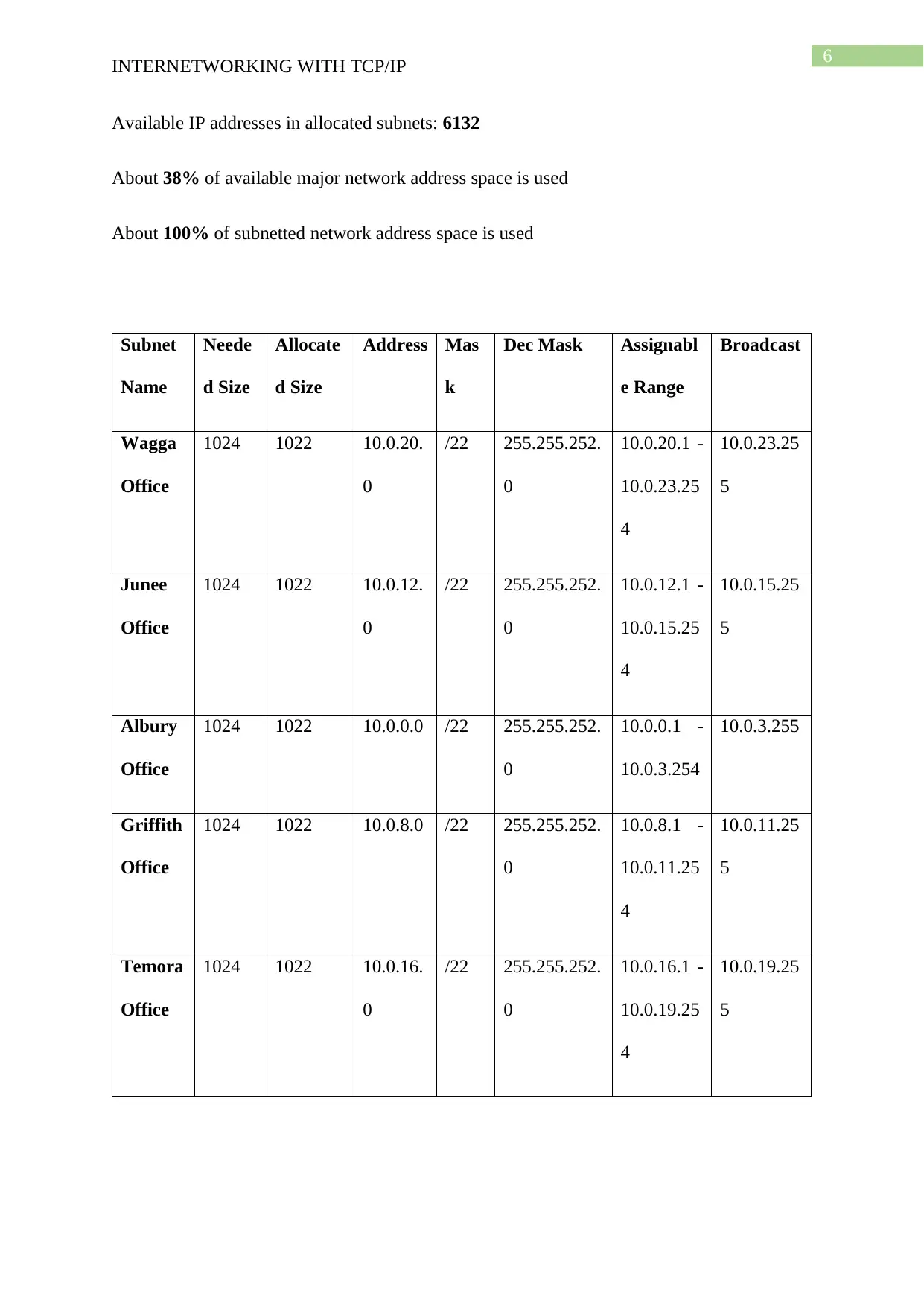
6
INTERNETWORKING WITH TCP/IP
Available IP addresses in allocated subnets: 6132
About 38% of available major network address space is used
About 100% of subnetted network address space is used
Subnet
Name
Neede
d Size
Allocate
d Size
Address Mas
k
Dec Mask Assignabl
e Range
Broadcast
Wagga
Office
1024 1022 10.0.20.
0
/22 255.255.252.
0
10.0.20.1 -
10.0.23.25
4
10.0.23.25
5
Junee
Office
1024 1022 10.0.12.
0
/22 255.255.252.
0
10.0.12.1 -
10.0.15.25
4
10.0.15.25
5
Albury
Office
1024 1022 10.0.0.0 /22 255.255.252.
0
10.0.0.1 -
10.0.3.254
10.0.3.255
Griffith
Office
1024 1022 10.0.8.0 /22 255.255.252.
0
10.0.8.1 -
10.0.11.25
4
10.0.11.25
5
Temora
Office
1024 1022 10.0.16.
0
/22 255.255.252.
0
10.0.16.1 -
10.0.19.25
4
10.0.19.25
5
INTERNETWORKING WITH TCP/IP
Available IP addresses in allocated subnets: 6132
About 38% of available major network address space is used
About 100% of subnetted network address space is used
Subnet
Name
Neede
d Size
Allocate
d Size
Address Mas
k
Dec Mask Assignabl
e Range
Broadcast
Wagga
Office
1024 1022 10.0.20.
0
/22 255.255.252.
0
10.0.20.1 -
10.0.23.25
4
10.0.23.25
5
Junee
Office
1024 1022 10.0.12.
0
/22 255.255.252.
0
10.0.12.1 -
10.0.15.25
4
10.0.15.25
5
Albury
Office
1024 1022 10.0.0.0 /22 255.255.252.
0
10.0.0.1 -
10.0.3.254
10.0.3.255
Griffith
Office
1024 1022 10.0.8.0 /22 255.255.252.
0
10.0.8.1 -
10.0.11.25
4
10.0.11.25
5
Temora
Office
1024 1022 10.0.16.
0
/22 255.255.252.
0
10.0.16.1 -
10.0.19.25
4
10.0.19.25
5
Paraphrase This Document
Need a fresh take? Get an instant paraphrase of this document with our AI Paraphraser

7
INTERNETWORKING WITH TCP/IP
Culcair
n Office
1024 1022 10.0.4.0 /22 255.255.252.
0
10.0.4.1 -
10.0.7.254
10.0.7.255
INTERNETWORKING WITH TCP/IP
Culcair
n Office
1024 1022 10.0.4.0 /22 255.255.252.
0
10.0.4.1 -
10.0.7.254
10.0.7.255
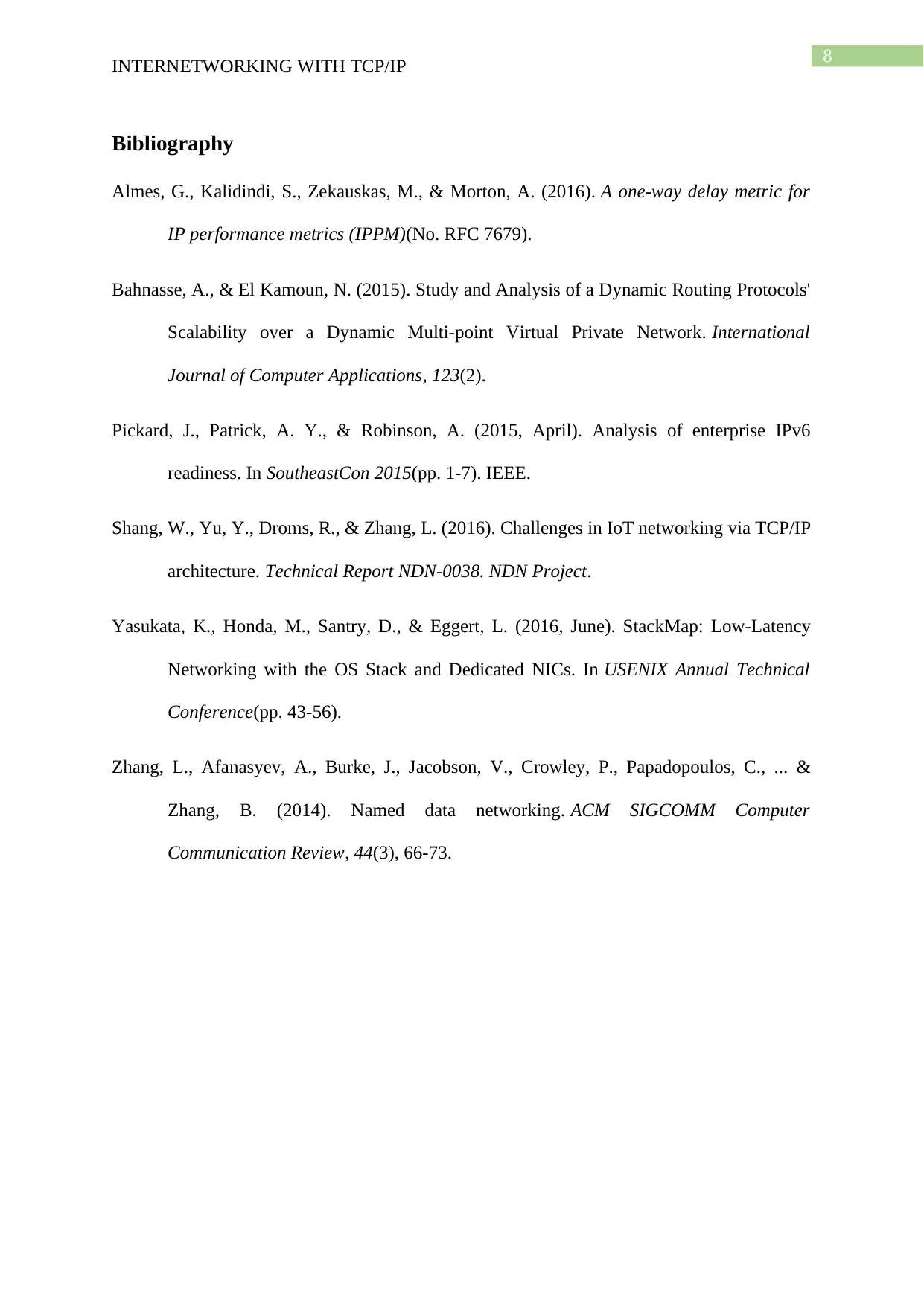
8
INTERNETWORKING WITH TCP/IP
Bibliography
Almes, G., Kalidindi, S., Zekauskas, M., & Morton, A. (2016). A one-way delay metric for
IP performance metrics (IPPM)(No. RFC 7679).
Bahnasse, A., & El Kamoun, N. (2015). Study and Analysis of a Dynamic Routing Protocols'
Scalability over a Dynamic Multi-point Virtual Private Network. International
Journal of Computer Applications, 123(2).
Pickard, J., Patrick, A. Y., & Robinson, A. (2015, April). Analysis of enterprise IPv6
readiness. In SoutheastCon 2015(pp. 1-7). IEEE.
Shang, W., Yu, Y., Droms, R., & Zhang, L. (2016). Challenges in IoT networking via TCP/IP
architecture. Technical Report NDN-0038. NDN Project.
Yasukata, K., Honda, M., Santry, D., & Eggert, L. (2016, June). StackMap: Low-Latency
Networking with the OS Stack and Dedicated NICs. In USENIX Annual Technical
Conference(pp. 43-56).
Zhang, L., Afanasyev, A., Burke, J., Jacobson, V., Crowley, P., Papadopoulos, C., ... &
Zhang, B. (2014). Named data networking. ACM SIGCOMM Computer
Communication Review, 44(3), 66-73.
INTERNETWORKING WITH TCP/IP
Bibliography
Almes, G., Kalidindi, S., Zekauskas, M., & Morton, A. (2016). A one-way delay metric for
IP performance metrics (IPPM)(No. RFC 7679).
Bahnasse, A., & El Kamoun, N. (2015). Study and Analysis of a Dynamic Routing Protocols'
Scalability over a Dynamic Multi-point Virtual Private Network. International
Journal of Computer Applications, 123(2).
Pickard, J., Patrick, A. Y., & Robinson, A. (2015, April). Analysis of enterprise IPv6
readiness. In SoutheastCon 2015(pp. 1-7). IEEE.
Shang, W., Yu, Y., Droms, R., & Zhang, L. (2016). Challenges in IoT networking via TCP/IP
architecture. Technical Report NDN-0038. NDN Project.
Yasukata, K., Honda, M., Santry, D., & Eggert, L. (2016, June). StackMap: Low-Latency
Networking with the OS Stack and Dedicated NICs. In USENIX Annual Technical
Conference(pp. 43-56).
Zhang, L., Afanasyev, A., Burke, J., Jacobson, V., Crowley, P., Papadopoulos, C., ... &
Zhang, B. (2014). Named data networking. ACM SIGCOMM Computer
Communication Review, 44(3), 66-73.
⊘ This is a preview!⊘
Do you want full access?
Subscribe today to unlock all pages.

Trusted by 1+ million students worldwide
1 out of 9
Related Documents
Your All-in-One AI-Powered Toolkit for Academic Success.
+13062052269
info@desklib.com
Available 24*7 on WhatsApp / Email
![[object Object]](/_next/static/media/star-bottom.7253800d.svg)
Unlock your academic potential
Copyright © 2020–2025 A2Z Services. All Rights Reserved. Developed and managed by ZUCOL.




